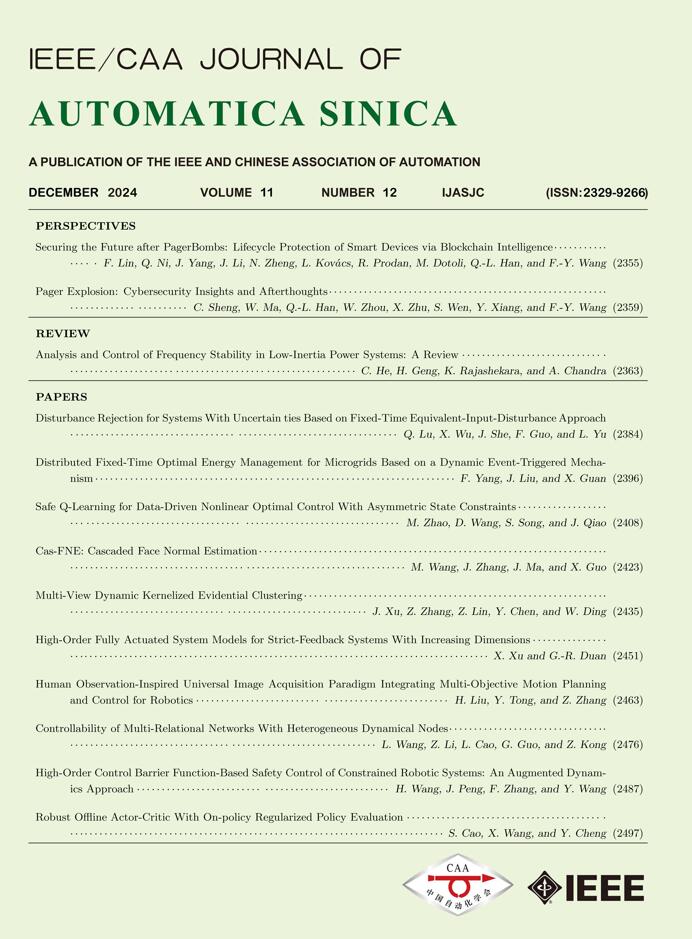 Volume 11
Issue 12
Volume 11
Issue 12
IEEE/CAA Journal of Automatica Sinica
| Citation: | X. Xu and G.-R. Duan, “High-order fully actuated system models for strict-feedback systems with increasing dimensions,” IEEE/CAA J. Autom. Sinica, vol. 11, no. 12, pp. 2451–2462, Dec. 2024. doi: 10.1109/JAS.2024.124599 |
High-Order Fully Actuated System Models for Strict-Feedback Systems W
ith Increasing Dimensions

| [1] |
M. Krstic and M. Bement, “Nonovershooting control of strict-feedback nonlinear systems,” IEEE Trans. Automatic Control, vol. 51, no. 12, pp. 1938–1943, 2006. doi: 10.1109/TAC.2006.886518
|
| [2] |
Z. Pan and T. Basar, “Adaptive controller design for tracking and disturbance attenuation in parametric strict-feedback nonlinear systems,” IEEE Trans. Automatic Control, vol. 43, no. 8, pp. 1066–1083, 1998. doi: 10.1109/9.704978
|
| [3] |
N. Bekiaris-Liberis and M. Krstic, “Stabilization of linear strict-feedback systems with delayed integrators,” Automatica, vol. 46, no. 11, pp. 1902–1910, 2010. doi: 10.1016/j.automatica.2010.07.008
|
| [4] |
W. Li, X. Yao, and M. Krstic, “Adaptive-gain observer-based stabilization of stochastic strict-feedback systems with sensor uncertainty,” Automatica, vol. 120, p. 109112, 2020. doi: 10.1016/j.automatica.2020.109112
|
| [5] |
Y. Li, Y. Fan, K. Li, W. Liu, and S. Tong, “Adaptive optimized backstepping control-based rl algorithm for stochastic nonlinear systems with state constraints and its application,” IEEE Trans. Cybernetics, vol. 52, no. 10, pp. 10542–10555, 2021.
|
| [6] |
P. V. Kokotovic, “The joy of feedback: Nonlinear and adaptive,” IEEE Control Systems Magazine, vol. 12, no. 3, pp. 7–17, 1992. doi: 10.1109/37.165507
|
| [7] |
M. Krstic, P. V. Kokotovic, and I. Kanellakopoulos, Nonlinear and Adaptive Control Design. John Wiley & Sons, Inc., 1995.
|
| [8] |
G. Meunier, B. Boulet, and M. Nahon, “Control of an overactuated cable-driven parallel mechanism for a radio telescope application,” IEEE Trans. Control Systems Technology, vol. 17, no. 5, pp. 1043–1054, 2009. doi: 10.1109/TCST.2008.2004812
|
| [9] |
R. Olfati-Saber, “Cascade normal forms for underactuated mechanical systems,” in Proc. 39th IEEE Conf. Decision and Control (Cat. No. 00CH37187), vol. 3, 2000, pp. 2162–2167.
|
| [10] |
G. Duan, “High-order fully actuated system approaches: Part I. Models and basic procedure,” Int. Journal of Systems Science, vol. 52, no. 2, pp. 422–435, 2021. doi: 10.1080/00207721.2020.1829167
|
| [11] |
G. Duan, “High-order fully actuated system approaches: Part II. Generalized strict-feedback systems,” Int. Journal of Systems Science, vol. 52, no. 3, pp. 437–454, 2021. doi: 10.1080/00207721.2020.1829168
|
| [12] |
G. Duan, “Fully actuated system approaches for continuous-time delay systems: Part 1. Systems with state delays only,” Science China Information Sciences, vol. 66, article 112201, 2023.
|
| [13] |
D.-W. Zhang, G.-P. Liu, and L. Cao, “Coordinated control of high-order fully actuated multiagent systems and its application: A predictive control strategy,” IEEE/ASME Trans. Mechatronics, vol. 27, no. 6, pp. 4362–4372, 2022. doi: 10.1109/TMECH.2022.3156587
|
| [14] |
Y. Yu, G.-P. Liu, Y. Huang, and J. M. Guerrero, “Coordinated predictive secondary control for dc microgrids based on high-order fully actuated system approaches,” IEEE Trans. Smart Grid, vol. 15, no. 1, pp. 19–33, 2024.
|
| [15] |
R. Meng, C. Hua, K. Li, and P. Ning, “Adaptive event-triggered control for uncertain high-order fully actuated system,” IEEE Trans. Circuits and Systems II: Express Briefs, vol. 69, no. 11, pp. 4438–4442, 2022.
|
| [16] |
R. Dong, C. Hua, K. Li, and R. Meng, “Adaptive fault-tolerant control for high-order fully actuated system with full-state constraints,” Journal of the Franklin Institute, vol. 360, no. 12, pp. 8062–8074, 2023.
|
| [17] |
M. Cai, X. He, and D. Zhou, “Fault-tolerant tracking control for nonlinear observer-extended high-order fully-actuated systems,” Journal of the Franklin Institute, vol. 360, no. 1, pp. 136–153, 2023. doi: 10.1016/j.jfranklin.2022.11.025
|
| [18] |
D. Gu and S. Wang, “A high-order fully actuated system approach for a class of nonlinear systems,” Journal of Systems Science and Complexity, vol. 35, no. 2, pp. 714–730, 2022. doi: 10.1007/s11424-022-2041-4
|
| [19] |
M. Cai, X. He, and D. Zhou, “Low-power fault-tolerant control for nonideal high-order fully actuated systems,” IEEE Trans. Systems, Man, and Cybernetics: Systems, vol. 53, no. 8, pp. 4875–4887, 2023.
|
| [20] |
D.-W. Zhang, G.-P. Liu, and L. Cao, “Proportional integral predictive control of high-order fully actuated networked multiagent systems with communication delays,” IEEE Trans. Systems, Man, and Cybernetics: Systems, vol. 53, no. 2, pp. 801–812, 2022.
|
| [21] |
L. Zhang, L. Zhu, and C. Hua, “Practical prescribed time control based on high-order fully actuated system approach for strong interconnected nonlinear systems,” Nonlinear Dynamics, vol. 110, no. 4, pp. 3535–3545, 2022. doi: 10.1007/s11071-022-07820-w
|
| [22] |
A.-G. Wu, J. Zhang, and Y. Ji, “A fully actuated system approach for stabilization of discrete-time multiple-input nonlinear systems with distinct input delays,” Journal of Systems Science and Complexity, vol. 35, no. 2, pp. 670–687, 2022. doi: 10.1007/s11424-022-2046-z
|
| [23] |
Q. Hu, B. Li, B. Xiao, and Y. Zhang, Control Allocation for Spacecraft Under Actuator Faults. Springer, 2021.
|
| [24] |
A. Witkowska and R. Śmierzchalski, “Adaptive dynamic control allocation for dynamic positioning of marine vessel based on backstepping method and sequential quadratic programming,” Ocean Engineering, vol. 163, pp. 570–582, 2018. doi: 10.1016/j.oceaneng.2018.05.061
|
| [25] |
D. Khimani and M. Patil, “Fault-tolerant sliding mode control for uncertain over-actuated systems,” IFAC Proceedings Volumes, vol. 47, no. 1, pp. 748–753, 2014. doi: 10.3182/20140313-3-IN-3024.00155
|